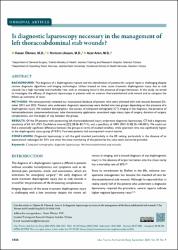Is diagnostic laparoscopy necessary in the management of left thoracoabdominal stab wounds?
Citation
Ökmen H, Ulusan K, Aren A. Is diagnostic laparoscopy necessary in the management of left thoracoabdominal stab wounds? Ulus Travma Acil Cerrahi Derg 2023;29(9):1026-1031.Abstract
BACKGROUND: The diagnosis of a diaphragmatic rupture and the identification of patients for surgical repair is challenging despite
current diagnostic algorithms and imaging technologies. Unless treated on time, acute traumatic diaphragmatic injury due to stab
wounds has a high mortality and morbidity rate, with an increasing trend in the presence of organ herniation. In this study, we aimed
to investigate the efficacy of diagnostic laparoscopy in patients with an anterior thoracoabdominal stab wound and to compare the
follow-up outcomes of cases.
METHODS: We retrospectively reviewed our institutional database of patients who were admitted with stab wounds between Oc tober 2012 and 2022. Patients who underwent diagnostic laparoscopy were divided into two groups depending on the presence of a
diaphragmatic injury. We analyzed demographics, the success of computed tomography (CT) imaging in the diagnosis, the presence of
hemomediastinum, pneumomediastinum, tube thoracostomy application, associated organ injury, type of surgery, duration of surgery,
complications, and the length of stay between the groups.
RESULTS: Of the 39 patients with penetrating left thoracoabdominal injury underwent diagnostic laparoscopy, CT had a diagnostic
sensitivity of 63.16% (95% Confidence interval [CI] 38.36–83.71%), and a specificity of 100% (95% CI 82.35–100.00%). We could not
find a statistically significant difference between the groups in terms of studied variables, while operation time was significantly higher
in the diaphragmatic injury group (P<0.01). Fourteen patients had accompanied visceral injuries.
CONCLUSION: Diagnostic laparoscopy is still the gold standard particularly in the ER setting, particularly in the absence of an
experienced radiologist for 24 h and when the close monitoring of the patient by the same team cannot be provided
Source
Ulusal Travma ve Acil Cerrahi DergisiVolume
29Issue
9URI
https://jag.journalagent.com/travma/pdfs/UTD_29_9_1026_1031.pdfhttps://doi.org/10.14744/tjtes.2023.33423
https://hdl.handle.net/20.500.12780/737


















